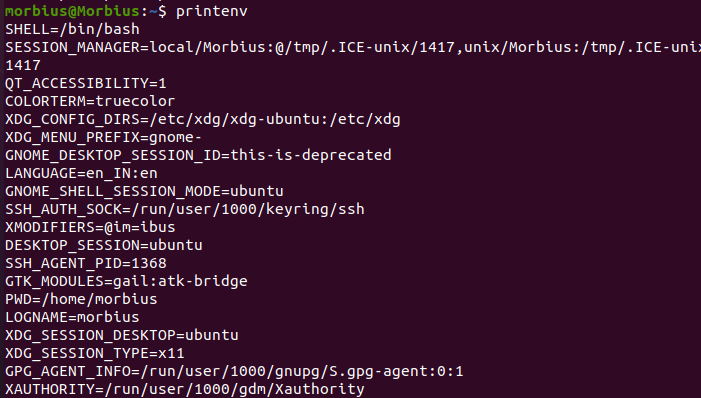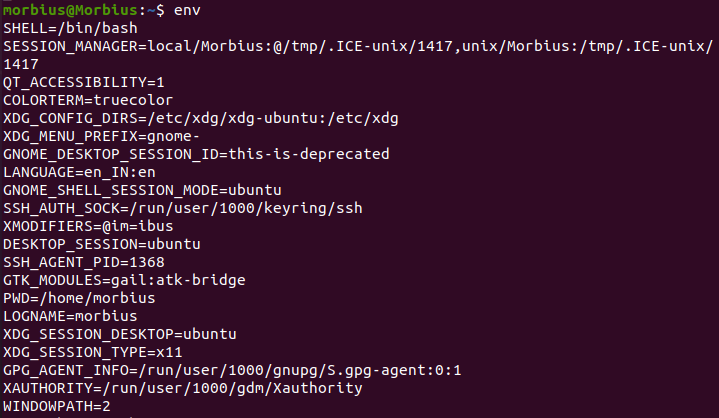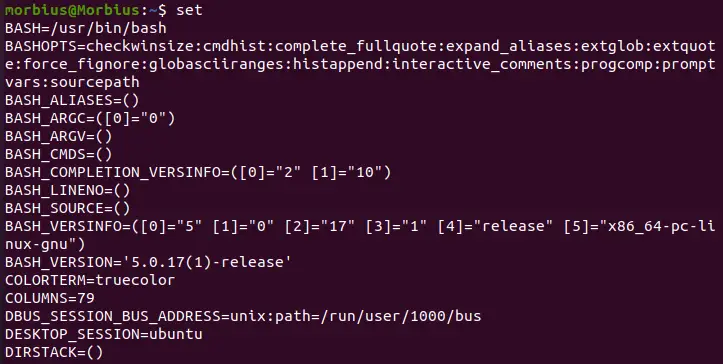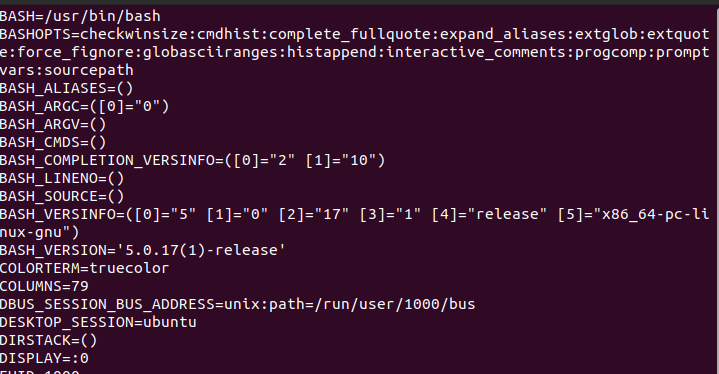In this way, the shell keeps track of all settings and information to maintain the environment. Shells build an environment each time they start a session that contains variables that define a system’s properties. So, if you want to know the methods to bash print all environment variables and values, then read this blog to get a brief on it.
Bash Print All Environment Variables and Values
By using the commands env or printenv, we can see all of our environment’s variables. So here is the following command and its output:
Both printenv and env produce similar results. They differ only in how they carry out certain tasks. When you use printenv, for example, you can see the values of specific variables using the below command:
According to what we learned above, child processes usually inherit the environment variables from parent tasks, allowing you to easily override or add variables to them.
Printenv displays that several environmental variables have been set without our input through our system files and processes.
You can use the set command for this. Without any other parameters, typing set will get us a list of environmental variables, all shell variables, shell functions, and local variables:
Most of the time, this list is very long. So, you can use the following command for the lesser output:
It is probably not necessary to learn about all of the Bash functions, for instance.
To clean up the output, we can specify to operate in POSIX mode, which will not print shell functions. So that it doesn’t change any current environment, we can run this in a subshell:
There are some environmental variables and shell variables that must be listed here.
The output of these commands will not match the output of env or printenv, so we cannot obtain only shell variables using these comparisons, but using these commands will give us a partial list:
While this is true, a few environmental variables may still be present since printenv and env don’t quote strings as they do.
In your session, you will still see the environment variables and shell variables you set.
There are many uses for these variables. These technologies offer an alternative to writing changes to files to set persistent session values.
Common Linux Variables
We display values of shell variables in Linux using the printf/echo commands:
| System Variable | Commands | Description |
| BASH_VERSION | BASH_VERSION | This variable contains the current version of bash. |
| HOSTNAME | HOSTNAME | Computer name. |
| CDPATH | CDPATH | cd command’s search path. |
| HISTFILE | HISTFILE | Command history is saved in this file. |
| HISTFILESIZE | HISTFILESIZE | In the history file, this is the maximum number of lines. |
| HISTSIZE | HISTSIZE | Command history memory size. It is set by default to 500. |
| HOME | HOME | The home directory of the current user. |
| IFS | IFS | Internal Field Separators split words after expansion and lines into words with the built-in command read. |
| LANG | LANG | This is used by any category not selected specifically with a variable beginning with LC_ to determine the locale category for that category. |
| PATH | PATH | This is the search path for commands—the shell searches for commands in the directories delimited by colons. |
| PS1 | PS1 | Set the prompts. |
| TMOUT | TMOUT | Read built-in command timeout by default.
An interactive shell also interprets a value of seconds as the time after a command is issued before submitting it. It will log the user out without input. |
| TERM | TERM
export TERM=vt100 |
Choose a terminal type to log in with. |
| SHELL | SHELL | The login shell path is set here. |
| DISPLAY | DISPLAY
export DISPLAY=:0.1 |
Display the name X |
| EDITOR | export EDITOR=/usr/bin/vim | Set the name of the default text editor. |
Conclusion
So, it was the brief information on the bash print of all environment variables and values. We have included the best possible details to view the environment variable through the Linux terminal. Make sure you visit our official website to know more about Linux.






